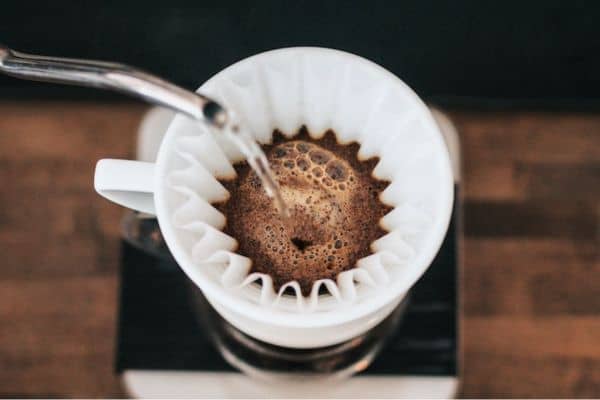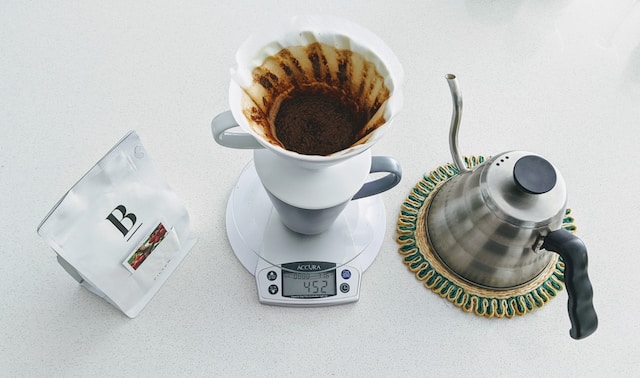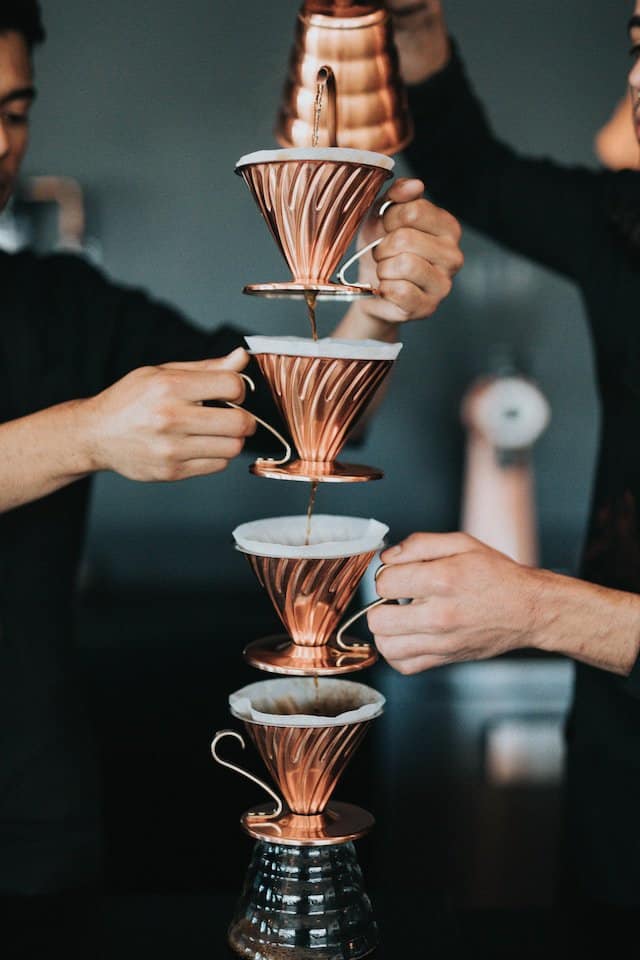Last updated on June 24th, 2023 by Catherine Reed

If you’re a coffee enthusiast like me, getting your daily morning cup isn’t just a habit; it’s an outright necessity. That’s why it’s so frustrating if you start your routine only to discover you have no coffee filter for your coffee maker.
You might think you’re just out of luck or assume you’ll have to make a trip to a nearby café for your daily cup of joe.
But then, you might also start wondering, “Is there a substitute for a coffee filter?” And the answer is yes; there are several options that work as reasonable coffee filter substitutes.
So, what can you use instead of a filter for coffee? Well, that’s what I’m here to discuss. Come with me as we explore what to use as a coffee filter substitute, how well each option works, and more.
A Guide to Traditional Coffee Filters

Photo by Kris Gerhard
Types
Traditional coffee filters come in two basic types: conical and basket. Conical versions are cone-shaped, while basket versions have a flat bottom with fluted sides that lean slightly outward. Generally, conical coffee filters are used for pour-over coffee, while most automatic coffee makers need basket coffee filters.
Sizes
Basket filters are available in several sizes, usually based on the number of cups the device can make at a time. For basket filters, the 8 to 12-cup size is one of the most widely used sizes, but there are others available.
With conical filters, the sizes are numbered – #1, #2, #4, and #6 – with lower numbers working for smaller coffee makers and higher numbers pairing with larger ones.
Material
Most disposable coffee filters are paper products, and they usually come in white or tan. Tan versions are unbleached, so they don’t go through any chemical processes to make them appear white. As a result, unbleached ones are generally considered more environmentally friendly.
You can also purchase reusable coffee filters designed explicitly for specific types of coffee makers. Basket versions featuring wire mesh are the most common, but you can also find metal versions for coffee makers that require conical designs.
Coffee Filter Substitutes and Alternatives

Photo by Nathan Dumlao
Alright, so you’re out of coffee filters, and you want to know about your options. Fortunately, I’ve tried several coffee filter substitutes and quite a few work reasonably well. Just keep in mind that each has its own fair share of pros and cons, so you can use that information to choose your best option.
So, if you’re wondering, “What can I use if I don’t have any coffee filters?” here are some of the best coffee filter substitutes.
Reusable Tea Strainer
Along with being a coffee drinker, I also enjoy the occasional cup of tea, and I prefer to buy my tea loose. As a result, I have a few reusable tea strainers around my kitchen, and I’ve used them to make coffee in a pinch.
Along with being a more sustainable choice, tea strainers are heat-resistant and do a good job of containing medium-to-coarse grounds. Plus, they work for a single cup of coffee, which is nice if you don’t need a whole pot.
Pros
- Reusable option
- Designed for brewing in hot water
- Can work for pour-over or single-cup steeping
Cons
- Fine grounds may leak out
- Non-tea drinkers may not have one conveniently available
How to Use a Tea Strainer as a Coffee Filter
Using a tea strainer is one of the simplest coffee filter substitutes. Simply add your grounds to the strainer, place it over the opening of your coffee cup or pot, and pour the hot water over the top. In some cases, you’ll want to let it steep for a bit, but once that’s done, you’re usually good to go.
Fillable Tea Bags
If you don’t have coffee filters, but you have tea bags that you fill with tea – instead of the ones that already have tea inside – you have an excellent coffee filter substitutes on your hands.
The material isn’t unlike a coffee filter, and in my experience, the results are very similar. Keep reading to see more about the pros and cons of this coffee filter substitutes.
Pros
- Disposable, and many are even compostable
- Can contain fine coffee grounds
- Relatively low cost
Cons
- Might take several tea bags if you need to brew a large pot
- Grounds can leak out if the bags aren’t correctly sealed or closed
How to Use Fillable Tea Bags as Coffee Filters
Generally, this option is very simple.
- Take the fillable tea bags and add coffee one tablespoon at a time, watching to make sure you don’t overfill the tea bag.
- If one bag doesn’t hold all the grounds you need to use, start filling new ones until you reach the correct quantity of grounds.
- Seal the bags in accordance with the directions, place them in your basket, and then brew your coffee as usual.
Fine Mesh Sieve
Fine mesh sieves aren’t wholly unlike the metal reusable coffee filters you find on the market, though the holes can be a bit wider. As a result, it can work well for medium to coarse grounds, particularly if you’re making pour-over coffee. But there are a few drawbacks to this option, as outlined below.
Pros
- Works well for pour-over coffee methods
- Best for medium or coarse grounds
- Reusable option
Cons
- Sieve might not fit if you’re using a drip coffee machine
- Fine grounds may leak out
How to Use a Fine Mesh Sieve Instead of a Coffee Filter
Generally, you use a fine mesh sieve similarly to how you’d use a tea strainer. Add your coffee grounds to the sieve, place it in a cup or pot, and pour hot water over the top. Then, let it all steep for a few minutes, pull out the sieve, and you’ve got yourself a nice cup or pot of coffee.
Cheesecloth
Using a cheesecloth substitute coffee filter is one of my preferred options, as it’s easy to cut and fold to fit into a basket. It’s also lightweight, disposable, and compostable. Plus, it’s designed with food preparation in mind, so you won’t find any dangerous chemicals.
But there are some catches to using cheesecloth, particularly since the weave isn’t particularly tight. Take a look below to see the pros and cons of cheesecloth as coffee filter substitute.
Pros
- Easy to cut and fold
- Disposable and compostable
- Designed to be food-safe
Cons
- Fine grounds may not stay in the cheesecloth, causing them to end up in your cup
- Coffee may wick through the material, leading to drips
How to Use Cheesecloth as a Substitute Coffee Filter
When using cheesecloth as a coffee filter substitute, you need to make sure you use several layers. You can either fold the cheesecloth or cut it into pieces and layer them over each other. The goal is to have enough layers so that the grounds won’t slip through.
Place the cheesecloth in the basket, secure the edges with a rubber band, add your coffee, and you’re all set to brew.
Cloth Napkin
One time, I was really in a bind, and I had to make my morning pot of coffee using a cloth napkin as a coffee filter. Overall, this option isn’t the worst. Cloth napkins are tough, and water makes its way through the fabric just fine. However, this option isn’t ideal, as outlined in the cons list below.
Pros
- Reusable option
- Works for pour-over, drip baskets, or single cups
- Can contain even the finest coffee grounds
Cons
- Napkins may end up with stains
- Laundry products used to wash them might get into your coffee
- Coffee may seep up through the fabric, leading to drips
How to Use Cloth Napkins in Place of a Coffee Filter
If you’re using a cloth napkin as a coffee filter, you simply place the napkin in the spot where you’d typically position a filter. Ideally, you want to secure it using a rubber band, or the edges may slip inside. Once you do that, you can make your coffee as you usually would.
Paper Towels
Personally, paper towels are my least favorite coffee filter substitute. But if you’re in need of an emergency coffee filter, the paper towel coffee filter is typically the most accessible. After all, most households have a roll of paper towels.
However, this approach is potentially the most likely to lead to a failure during brewing. Seams between sheets can come apart during the process, causing the grounds to fall through the filter. But if you’re careful with seam positioning, it can still do the trick.
Pros
- Accessible
- Low-cost
- Disposable or Compostable
- Works for pour-over or drip baskets
Cons
- Paper towel seams may separate during brewing
- Seams may tear when throwing away makeshift filter and grounds
- Chemicals used in paper towel production may get into your coffee
How to Use Paper Towels Instead of Coffee Filters
Using paper towels as a coffee filter substitute is relatively straightforward. If you have full-size paper towel sheets, fold them in half to create long rectangles. Then, take the drip basket and carefully line it with several paper towels.
Ideally, you want to lay the paper towels in different directions, with them crossing over in the middle. If there are any seams connecting paper towel segments to each other, don’t put them in the center, as that’s the most likely failure point.
Generally, four layers of paper towel in the center will do the trick. If you can add a rubber band around the outside of the drip basket to hold the paper towels in place, it’s worth doing. That keeps the edges of the paper towel in place, essentially preventing slippage.
After that, make sure the drip basket is firmly seated, add your chosen coffee, and let the hot water flow.
FAQs
How Can I Make a Homemade Coffee Filter?
If you want to make a DIY coffee filter, using the paper towel or cloth napkin options above is typically your best bet. If you’re concerned about staining a cloth napkin, stick with paper towels. They’re disposable and even compostable, and it just takes a bit of layering or folding to make them work.
Can I Use Wax Paper as a Coffee Filter?
If you need to figure out how to make coffee without a filter or a paper towel (or any of the other coffee filter substitutes above), you might wonder if wax paper will work instead if you have that on hand. Generally, this option isn’t one I’d recommend.
Wax paper, as the name suggests, is coated with wax. Wax is water-resistant, so the water you use for your coffee won’t drip through the material.
Plus, it’s not heat-resistant, as the wax can melt if the temperature gets too high. Even though the wax is food-safe, unless you want a bit of wax in your coffee and in your coffee maker, it’s better to use another option.
Using parchment paper as a coffee filter has similar drawbacks. Parchment paper just isn’t porous enough to work particularly well, so you’re better off going in another direction.
Can You Use Cupcake Liners for Coffee Filters?
While cupcake filters may look like small coffee filters, they won’t work well as a coffee filter substitute. The material used to create them isn’t porous. If it was, they’d leak while holding cupcake batter.
And since they aren’t porous, the water won’t make its way out of the cupcake liner if you try to make coffee. Since that’s the case, it’s best to use another option.
Coffee Has Never Read This Good!
Sign up for a FREE newsletter to the best home brewing tips and guides
Thank you for subscribing to The Cup Coffee House Crew! There's a surprise in your Inbox 🙂
Something went wrong.
- About the Author
- Latest Posts

Catherine Reed is a freelance writer and coffee enthusiast. She has been a lover of coffee, espresso, and various café-style concoctions for more than 20 years, and enjoys exploring everything the world of coffee has to offer. Whether it’s trying out new coffee technologies or exploring small-batch creations from independent micro-roasters, Catherine is open to any coffee experience, and aims to share everything she’s learned with discerning readers interested in leveling up their coffee game.

